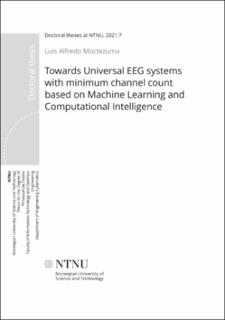| dc.description.abstract | The aim of this thesis is to move one step forward towards the concept of electroencephalographic (EEG) systems that can achieve the same objectives as high-density EEG with a minimum required number of channels. This requires EEG signal analysis, computational intelligence, and optimization techniques that can systematically identify the minimum number of channels that fulfills the objectives currently achieved with high-density EEG systems. Achieving this goal will pave the way towards the hardware-software realization of user-centric, easy-to-use, readily affordable EEG systems for universal applications. Enabling portability while ensuring performance of comparable or higher quality than that of high-density EEG will expand the accessibility of EEG to non-traditional users and personal applications moving EEG out of the lab. The application horizon will be expanded from experimental research to clinical use, to the gaming industry, intelligence and security sectors, education and daily use by people for self-knowledge.
The methods proposed in the thesis comprise the combination of feature extraction techniques and channel selection algorithms with optimization techniques that allow extracting the most essential information from a minimum set of required EEG channels that were tested in two cases-studies: Epileptic seizure classification, and EEG-based biometric systems. The Discrete Wavelet Transform (DWT) and Empirical Mode Decomposition (EMD) were used to decompose EEG signals into different frequency bands and then four features were computed for each sub-band, the Teager and Instantaneous energies and the Higuchi and Petrosian fractal dimensions.
For the optimization stage, non-dominated sorting genetic algorithms (NSGA) were used for channel selection, using binary values to represent the channels in the chromosomes, 1 if the channel is used in the classification and optimization process, and 0 if not. Additional genes to represent important parameters for the classifiers were added using integer and decimal values.
For Case-study 1, NSGA-III selected one or two channels from a set of 22 for epileptic seizure classification, obtaining an accuracy of up to 0.98 and 1.00, respectively, using EMD/DWT-based features.
For Case-study 2, a task-independent, resting-state-based biometric system using Local Outlier Factor (LOF)- and DWT-based features showed a True Acceptance Rate (TAR) of up to 0.993_0.01 and a True Rejection Rate (TRR) of up to 0.941_0.002 using only three channels selected by NSGA-III from a set of 64.
The results presented herein can be considered to be a first proof-of-concept, showing that it is possible to reduce the number of required EEG channels for classification tasks and opens the way to explore these methods on other neuroparadigms. This will lead to reduced real-time computational costs for EEG signal processing, removing task-irrelevant and redundant information, as well as reducing the preparation time for use of the EEG headsets.
The results of such a reduction in the number of required EEG channels will make possible a low-power hardware design, expanding the range of EEG-based applications from clinical diagnosis and research to health-care, to non-medical applications that can improve our understanding of cognitive processes, learning and education and to the discovery of current hidden/unknown properties behind ordinary human activity and ailments. | en_US |
